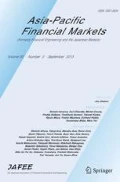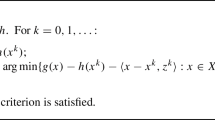Abstract
We propose a new method forfailure discrimination and rating of enterprises using financialdata compiled from their balance sheets. No particular distributional assumption is made on the underlying data. Our method automatically discriminates and rates many enterprises using mathematical programming methods. We separate multi-dimensional data byhyperplane and hyper-ellipsoid, so that we can interpretthe results of classification from the geometric point of view. Theproblem to be solved here is a linear programming problem orsemi-definite programming problem which can be solved efficiently byinterior point algorithms. Numerical simulations usingreal data show that hyper-ellipsoid separation generates a result which can be used for practical purposes.
Similar content being viewed by others
References
Altman, E. I. and Nelson, A. D. (1968) Financial ratios, discriminant analysis and the prediction of corporate bankruptcy, J. Finance 23, 589-609.
Altman, E. I. (1984) Corporate Financial Distress, John Wiley & Sons.
Asai, T. (1998) Prediction of corporate failure by linear programming, Graduation Thesis (in Japanese), Department of Industrial Engineering and Management, Tokyo Institute of Technology.
Chvátal, V. (1983) Linear Programming, Freeman and Co.
Bradley, P. S., Fayyad, U. M., and Mangasarian, O. L. (1999) Mathematical programming for data mining: formulations and challenges, INFORMS J. Comput. 11, 217-238.
Fujisawa, K., Kojima, M., and Nakata, K. (1999) Semidefinite programming algorithm, Research Reports on Mathematical and Computing Sciences, Tokyo Institute of Technology, 1999.
Gupta, Y., Rao, R., and Bagchi, P. (1990) Linear goal programming as an alternative to multivariate discriminant analysis, J. Busin. Finance Account. 17, 593-598.
Helmberg, C., Rendl, F., Vanderbei, R. J., and Wolkowicz, H. (1996) An interior-point method for semidefinite programming, SIAM J. Optim. 6, 342-361.
Kijima, M. and Komoribayashi, K. (1999) Mathematical Models for Evaluating Credit Risk, (in Japanese), Asakura-shoten Publishing Co.
Mangasarian, O., Street, W., and Wolberg, W. (1995) Breast cancer diagnosis and prognosis via linear programing, Operat. Res. 43, 570-577.
Moridaira, S. (1998) Estimation of failure probability and credit risk: a survey (in Japanese), JAFEE J. 2, 3-35.
Vandenberghe, L. and Boyd, S. (1996) Semi-definite programming, SIAM Rev. 38, 49-95.
Author information
Authors and Affiliations
Rights and permissions
About this article
Cite this article
Konno, H., Kobayashi, H. Failure Discrimination and Rating of Enterprises by Semi-Definite Programming. Asia-Pacific Financial Markets 7, 261–273 (2000). https://doi.org/10.1023/A:1010013117888
Issue Date:
DOI: https://doi.org/10.1023/A:1010013117888




